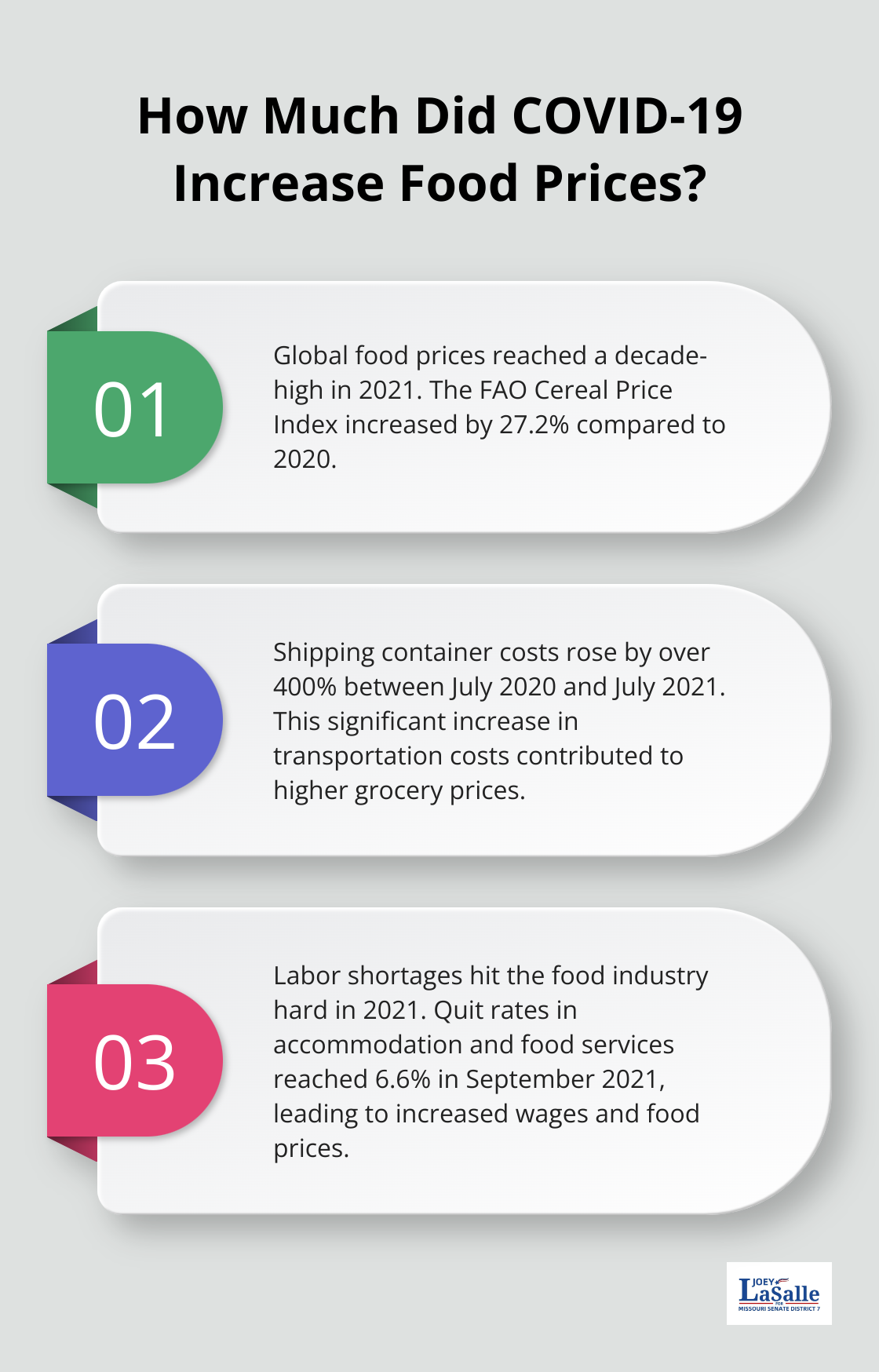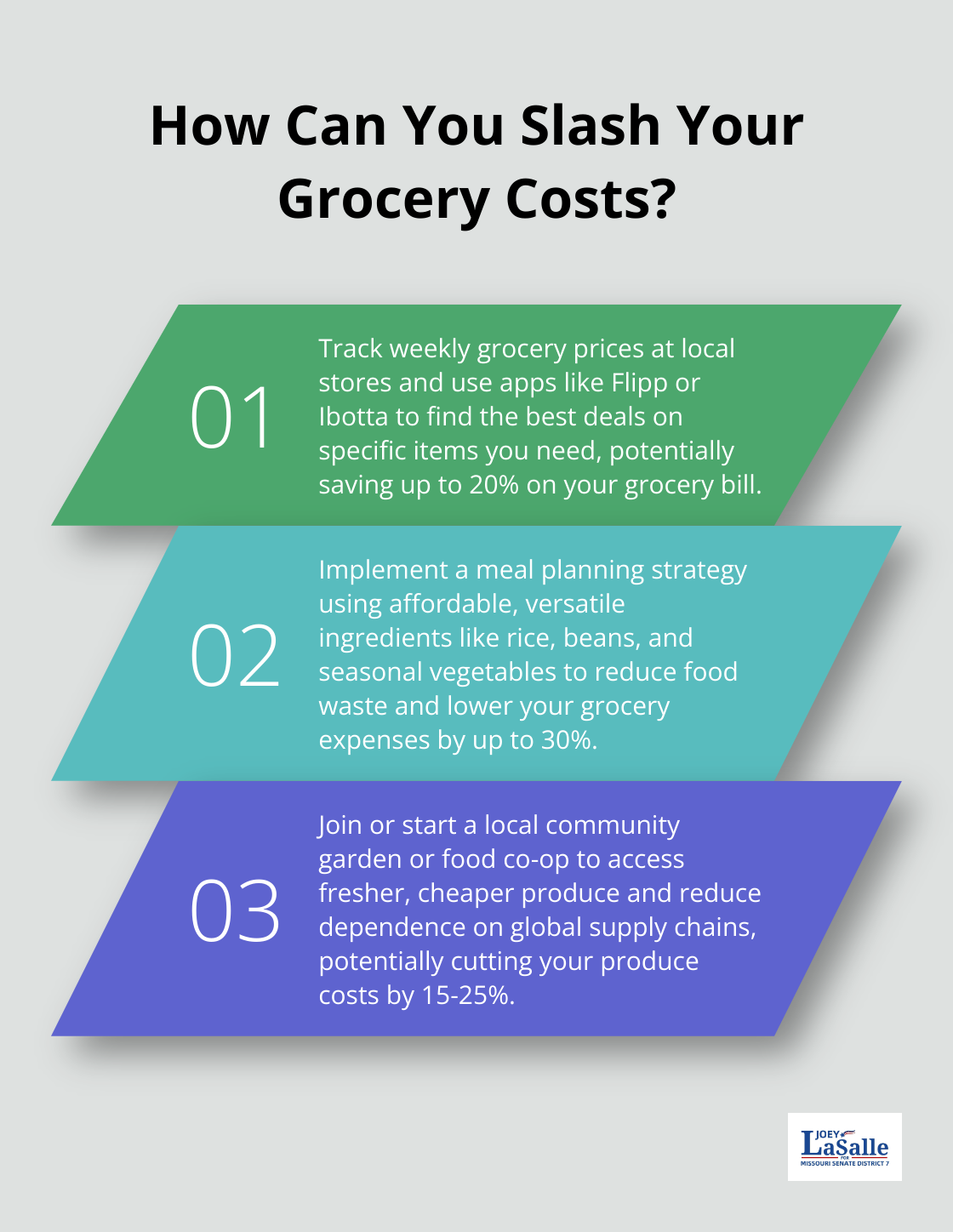At LaSalle for MO7, we’ve noticed a growing concern among our community about the rising cost of groceries. The impact of economic policies and inflation taxes has become increasingly evident in our daily lives.
We’ll explore the key factors driving these price increases, from global supply chain disruptions to agricultural challenges. Understanding these issues is crucial for consumers looking to manage their food budgets effectively in today’s economic landscape.
How Global Supply Chains Affect Your Grocery Bill
COVID-19’s Lasting Impact on Food Production
The COVID-19 pandemic has left an indelible mark on food production and distribution. Global food prices reached their highest levels in a decade in 2021, with the FAO Cereal Price Index increasing by 27.2% compared to 2020 (as reported by the Food and Agriculture Organization of the United Nations). This surge resulted from production slowdowns and temporary closures of food processing plants during lockdowns.
Transportation Woes and Rising Shipping Costs
Transportation issues have exacerbated the problem. The cost of shipping containers exploded during the pandemic, with rates increasing by over 400% between July 2020 and July 2021 (according to Drewry’s World Container Index). These increased costs often translate to higher grocery prices for consumers.
Labor Shortages in the Food Industry
Labor shortages have hit the food industry hard. The U.S. Bureau of Labor Statistics reported that quit rates in the accommodation and food services sector reached 6.6% in September 2021. This shortage of workers has led to increased wages, which in turn contributes to higher food prices.
Local Solutions to Global Problems
While global supply chain issues persist, local communities can take steps to mitigate some of these effects. Supporting local businesses and farmers can reduce reliance on complex global supply chains and potentially provide more stable prices for consumers.
The Role of Technology in Supply Chain Management
Innovative technologies (such as blockchain and AI) are emerging as potential solutions to supply chain disruptions. These tools can help improve transparency, traceability, and efficiency in the food supply chain, potentially leading to more stable prices in the long run.

As we consider the impact of global supply chains on grocery prices, it’s important to also examine the role of inflationary pressures in driving up costs. Let’s explore how factors like energy costs and monetary policies contribute to the rising prices we see at the checkout counter.
The Hidden Costs Behind Your Grocery Bill
The Energy Price Ripple Effect
Energy costs significantly impact food prices. The U.S. Energy Information Administration reported a 45% increase in average gasoline prices in 2021 compared to 2020. This surge in fuel costs directly affects transportation expenses for food products throughout the supply chain.

The impact extends beyond transportation. Higher energy prices increase the cost of producing fertilizers, operating farm equipment, and running food processing plants. These additional expenses ultimately reach consumers through higher grocery prices.
The Wage-Price Spiral
A trend of rising wages spans across industries. The U.S. Bureau of Labor Statistics reported a 4.7% increase in average hourly earnings for all employees from December 2020 to December 2021. While higher wages benefit workers, they also contribute to increased production costs for businesses, often resulting in higher consumer prices.
In the food industry, labor shortages have forced many companies to raise wages to attract and retain workers. These increased labor costs frequently translate to higher food prices for consumers.
Monetary Policy and Its Consequences
Central bank policies, particularly those implemented in response to the COVID-19 pandemic, have played a significant role in current inflationary pressures. The Federal Reserve’s expansionary monetary policy (including near-zero interest rates and large-scale asset purchases) has led to a substantial increase in the money supply.
Federal Reserve Economic Data (FRED) provides a measure of the U.S. money supply that includes all components of M1 plus several less-liquid assets. This data helps illustrate the changes in money supply that can contribute to inflationary pressures across various sectors, including food prices.
Local Action in a Global Context
These economic forces have a profound impact on communities across the nation. While these issues are complex and global in nature, local action can make a difference. Supporting local businesses and farmers can help mitigate some of these effects and keep more money circulating within communities.
As we navigate these challenging economic times, understanding the factors driving price increases becomes essential. The next section will explore how agricultural challenges further complicate the picture of rising grocery costs, adding another layer to this complex issue.
How Nature and Policy Shape Food Prices
Weather’s Unpredictable Influence on Crops
Extreme weather events now occur more frequently and severely, directly affecting crop yields. The U.S. has sustained 391 weather and climate disasters since 1980 where overall damages/costs reached or exceeded $1 billion (including CPI adjustment to 2024). These events, from droughts to floods, can destroy entire harvests, leading to scarcity and higher prices.

The severe drought in California in 2021 affected crop production. Such reductions in crop yields inevitably lead to higher prices at the grocery store.
The Rising Cost of Crop Inputs
Farmers now grapple with skyrocketing prices for essential inputs like fertilizers and pesticides. From January 2021 to January 2022, fertilizer prices increased by 66%. This dramatic rise stems partly from increased energy costs and supply chain disruptions.
These increased input costs force farmers to either absorb the losses or pass them on to consumers. Either way, it puts pressure on the entire food supply chain and ultimately affects the prices we see at the checkout counter.
Balancing Agriculture and Environment
Environmental regulations and land use changes also influence food prices. While these measures often prove necessary for long-term sustainability, they can increase short-term costs for farmers. For example, the implementation of buffer zones to protect water quality can reduce the amount of land available for crop production, potentially decreasing overall yield.
The Impact of Agricultural Policies
Government policies significantly shape the agricultural landscape and, consequently, food prices. Subsidies, trade agreements, and regulations all play a role in determining what farmers grow and how much consumers pay.
For instance, changes in ethanol policies can affect corn prices, which in turn impacts the cost of many food products (as corn serves as a key ingredient in numerous processed foods and as feed for livestock).
Technological Advancements in Agriculture
While challenges abound, technological innovations offer some hope for mitigating rising food costs. Precision agriculture techniques, drought-resistant crop varieties, and vertical farming methods all have the potential to increase yields and reduce input costs.
However, the adoption of these technologies often requires significant upfront investment, which can be a barrier for many farmers and may initially contribute to higher production costs.
Final Thoughts
The rising cost of groceries stems from a complex interplay of global and local factors. Supply chain disruptions, inflationary pressures, and agricultural challenges have all contributed to the price increases we see at the checkout counter. These issues, compounded by the lasting effects of the COVID-19 pandemic, have created a difficult situation for consumers.

At LaSalle for MO7, we understand the impact of economic policies and inflation taxes on our community’s daily lives. We address these challenges through fiscal policy reforms and job creation initiatives. Our goal is to create a more stable and prosperous economic environment for all residents of Missouri’s 7th District.
We encourage you to stay informed and engage in local politics. Support candidates who prioritize economic stability and community well-being (like us at LaSalle for MO7). To learn more about our efforts to create a safer, more prosperous, and equitable community, visit our campaign website.
Missouri’s Republican Supermajority and Joey LaSalle’s Role
Missouri’s Republican supermajority plays a key role in shaping legislative decisions and directing resources. Joey LaSalle has the skills and experience to work effectively within this political environment to advocate for District 7. His ability to navigate the supermajority is essential for addressing community concerns and driving meaningful change. To learn more about how the supermajority impacts state policies, explore the Missouri Senate District Map 2024 and details on Missouri State Senators 2024.
Call to Action:
Joey LaSalle takes a proactive approach to solving problems in District 7. He is committed to reducing crime, boosting the economy, creating jobs, and improving community resources like education, health services, and infrastructure. Kansas City has faced years of misrepresentation in Jefferson City. Now is the time for effective leadership that truly understands our community’s needs. Joey aims to lower taxes and ensure affordable housing, making him the only Republican candidate capable of genuinely representing Kansas City and Grandview in Missouri’s supermajority. Unlike typical politicians, Joey focuses on solving real problems and putting people first.
For more details on Joey’s plans for Missouri’s 7th District, visit joe4mo7.com. To see how he compares to other candidates, check out this article at Missouri Senate District 7 | KC Voter Guide 2024. You can also find additional insights about his campaign and political stance on Ballotpedia and his profile on Lyke. Joey proudly supports Tracey Chappell for prosecutor in Jackson County, the only candidate with the right experience to tackle the county’s challenges.
Additionally, we support Republican Derron Black’s initiatives in District 9. Like Joey, Derron is committed to authentic leadership that puts the community ahead of political ambitions.
For a stronger future in Kansas City and Grandview, vote for Joey LaSalle, the candidate who delivers real change. Stay connected with Joey on Facebook and Twitter and learn more about his priorities at joe4mo7.com. Together, we can bring the leadership Kansas City deserves to Jefferson City.
